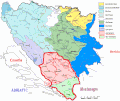| Upper Neretva Gornja Neretva | |
|---|---|
 A section of the Upper Neretva canyon, Ćepa (1006 m). | |
 | |
| Etymology | "Nera-Etwa" is Celtic for "Divinity that flows" referring to the Neretva River; Latin: Narenta, Narona, Naro for English: Narrative, Gurgle. |
| Nicknames | Nera; Emerald River; Modra rijeka (English: Purple River) |
| Location | |
| Country | Bosnia and Herzegovina |
| Region | South-East Central Bosnia and Herzegovina |
| District | Konjic, Kalinovik, Gacko |
| City | Konjic |
| Physical characteristics | |
| Source | Gredelj |
| • location | Lebršnik, South-East Central Bosnia and Herzegovina, Bosnia and Herzegovina |
| • elevation | 1,227 m (4,026 ft) |
| Mouth | Adriatic |
• location | Ploče, Dubrovnik-Neretva County, Croatia |
• elevation | 0 m (0 ft) |
| Length | 90 km (56 mi), EW |
| Discharge | |
| • average | 34.5 m3/s (1,220 cu ft/s) |
| Basin features | |
| River system | Dinaric Alps |
| Tributaries | |
| • left | Jezernica, the Živašnica (also known as the Živanjski Potok), Ladjanica, Župski Krupac, Bukovica, Šištica, Konjička Bijela |
| • right | Jezernica (also known as the Tatinac), Gornji i Donji Krupac, Ljuta (also known as the Dindolka), Jesenica, Bjelimićka Rijeka, Slatinica, Račica, Rakitnica, Konjička Ljuta, Trešanica, Neretvica |
| 90 km | |
The Upper Neretva (Serbo-Croatian : Gornja Neretva) is the upper course of the Neretva river, located in Bosnia and Herzegovina. It includes the mountainous area surrounding the Neretva, with human settlements, peaks and forests, streams and wellsprings, three major glacial lakes near the river and more scattered across the mountains of Treskavica and Zelengora, in a wider area of the Upper Neretva.
Contents
- Geography and hydrography
- Course
- Streams and tributaries
- Lakes
- Natural heritage and protection
- Fresh water resources
- Endemic and endangered ichthyofauna
- Dam problems
- See also
- References
- Sources
- External links
The Neretva is divided into three common hydrological sections: upper, middle and lower. [1]
The Neretva has been harnessed and controlled to a large extent by four HE power-plants with large dams (higher than 15 meters) [2] and their storage lakes. It is also recognized for its natural beauty, [3] diversity of its landscape and visual attractiveness. [3] [4]



